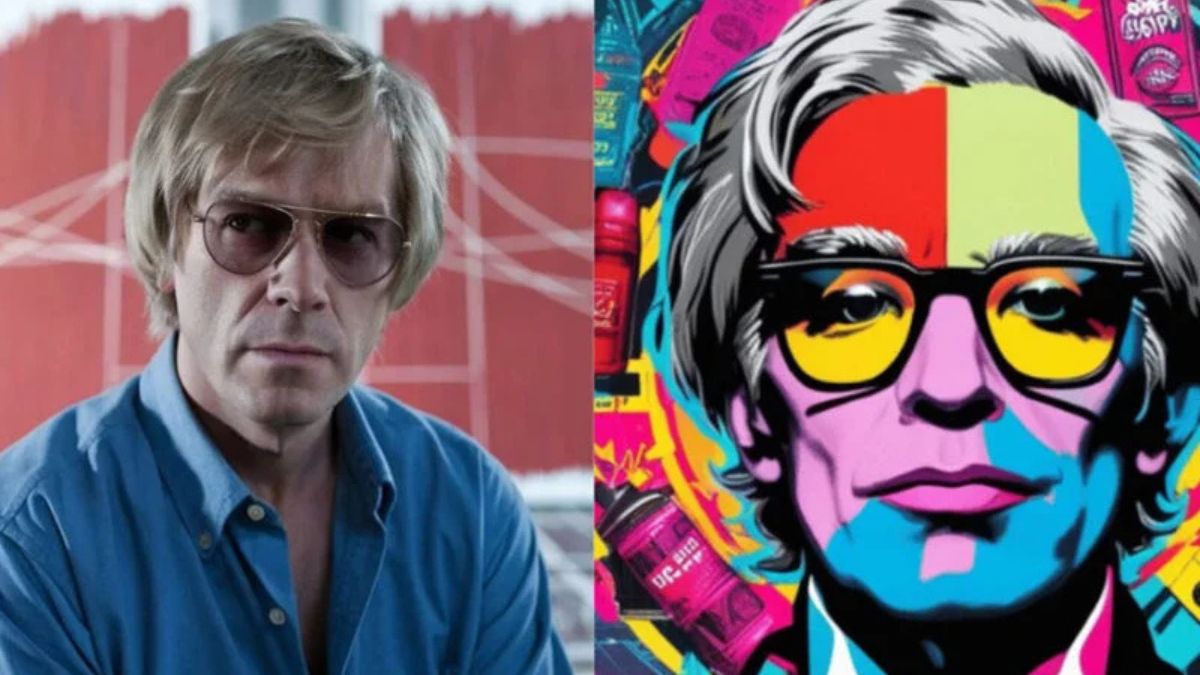BIOGRAPHY
AndyWarhella: A Pop Paradox Reborn

There are artists, and then there are movements masquerading as people. Somewhere in the smoke-hazed echo of 1960s Factory parties and the glitching reels of digital TikTok loops, one name straddles both realms like a psychedelic centaur: andywarhella. Not quite man, not quite myth, and certainly not just an echo of a silver-haired legend from Pittsburgh. AndyWarhella is a cultural palimpsest—part homage, part evolution, all provocation.
Born not in a cradle but on the edge of a screen, AndyWarhella is a name that first began to shimmer on the fringes of the digital art underground in the mid-2010s. To the casual scroller, he was a vaporwave meme-lord with a Warholian obsession. But for the growing community of alt-art collectors, crypto-creatives, and highbrow punks, andywarhella is the bridge between pixels and paint, past and future, commercial chaos and meditative irony.
Who—or What—is AndyWarhella?
At first glance, andywarhella feels like a handle—a clever mashup meant for Twitter bios and Discord servers. But what started as a satirical riff on Andy Warhol’s cultural legacy grew limbs, sprouted fingers, and picked up a digital brush. The character of andywarhella morphed into a full-blown persona: equal parts artist, social commentator, crypto-anarchist, and post-ironic messiah of the millennial mindscape.
Behind the alias? A cloaked identity, naturally. Though a few art-world insiders whisper the real name (a cross between a tech dropout and an ex-Vice contributor), the creator has never officially stepped into the spotlight. Instead, andywarhella lets the work do the speaking—and the shouting, glitching, looping, and trolling.
This anonymity isn’t a gimmick. It’s a philosophy. In a world obsessed with branding the self, andywarhella obliterates the ego, letting art exist untethered from the artist. A wink to Warhol’s own dispassionate commentary on celebrity culture, perhaps. Or maybe just a refusal to be categorized.
Pop Art Rebooted—With Malware and Memes
Andy Warhol once said, “In the future, everyone will be world-famous for 15 minutes.” AndyWarhella responds: “In the present, everyone is famous for 15 seconds… until the algorithm buries them.”
Where Warhol gave us Campbell’s Soup and Marilyn in silkscreen Technicolor, andywarhella offers TikTok loops of Ronald McDonald breaking the fourth wall or AI-generated selfies of 20th-century dictators reimagined as Instagram influencers. His canvases aren’t stretched linen—they’re screen grabs, glitch gifs, corrupted NFTs, and JPEGs posted at 3:00 a.m. to obscure subreddits.
It’s art made from the detritus of the internet—and it slaps.
His most viral series, CAPTCHA Christ, featured hyper-stylized renderings of Jesus overlaid with spam filters, bot-verification grids, and corporate disclaimers. Critics called it blasphemy; others called it brilliant. AndyWarhella? He just called it “Monday.”
The Aesthetic: Filtered Irony Meets Neon Nihilism
The andywarhella aesthetic doesn’t aim to be beautiful—it aims to be true. Not in a literal sense, but in the sense that every swipe, scroll, and screenshot has become a form of modern truth. If Warhol flattened fame into screen prints, andywarhella pulverizes it into data.
Expect palettes that make your eyes twitch: hyper-saturated neon, pixelated gradients, nostalgic VHS filters, and glitching overlays that almost seem to gaslight you mid-viewing. And yet, beneath the chaos lies a deep symmetry. A harmony born of visual overload. You don’t view an andywarhella piece; you experience it—like being sucked into a browser history you didn’t know you had.
The artist’s signature motif? Recoding familiar icons into unsettling relics of the now. Mona Lisa with AirPods. Gandhi in a Supreme hoodie. Bezos crucified on a blockchain. Every image is a meme grenade: funny, then disturbing, then kind of… profound.
AndyWarhella and the NFT Revolution
You can’t talk about andywarhella without diving into the blockchain rabbit hole. Unlike many artists who reluctantly dipped a toe into NFTs, andywarhella belly-flopped into the metaverse and started throwing conceptual pool parties.
In 2021, his Vaporized Soup Cans—a direct nod to Warhol’s classic series—dropped on the Ethereum-based SuperRare platform and sold out in under 48 hours. But these weren’t just pretty pictures. Each NFT came with a set of coded “truth bombs”—interactive metadata that revealed cryptic political commentary, personalized hallucinations, and even digital viruses that would briefly hijack your screen.
Collectors were either delighted or horrified. Either way, they couldn’t look away.
Today, owning an original andywarhella NFT isn’t just about clout. It’s membership in a strange, vibrant underground collective. Holders get early access to drops, cryptic newsletters titled Post-Modern Prayers, and even “emotional stock tips” (read: fortune cookie poetry disguised as market analysis).
The Philosophy: Post-Humanism in a Post-Truth World
While his critics accuse him of aesthetic trolling, andywarhella insists there’s method to his meme-ness. In one rare interview—posted as a deepfake of Ryan Seacrest—he described his mission as “deconstructing the myth of permanence in a world built on temporary clicks.”
Translation? Everything dies. Everything loops. Even Andy Warhol.
But instead of mourning culture’s decay, andywarhella celebrates it. His work is a neon wake for a digital civilization choking on its own reflections. If you’re confused by his art, that’s the point. Confusion is the new clarity.
He’s been called a “digital Dadaist,” a “pop prophet,” and once—by The New Yorker, no less—“a Warhol cosplay gone rogue.” But labels bounce off andywarhella like ad popups on an adblocker.
Influences: Warhol, Banksy, Basquiat… and Bugs Bunny?
It’s tempting to draw a straight line from Warhol to andywarhella, but the latter’s lineage is much messier—and more fun. Beyond Warhol’s detachment and repetition, you’ll find Banksy’s snark, Basquiat’s rage, and a dose of Looney Tunes chaos for good measure.
“Cartoons taught me more about reality than philosophy did,” he once tweeted (then deleted, then minted into an NFT).
There’s also a clear debt to Vaporwave aesthetics, glitch art pioneers like Rosa Menkman, and digital surrealists such as Beeple. But unlike some contemporaries chasing crypto highs, andywarhella remains weirdly grounded—philosophical, even. He creates like someone who knows art history, then breaks it like someone who doesn’t care.
Legacy-in-Progress
At just under a decade into public consciousness, the andywarhella myth is still unfolding. His exhibitions have migrated from screens to spaces—virtual and otherwise. In 2024, he staged CTRL+ALT+GOD, a “meta-mass” in an abandoned church in Berlin, livestreamed in VR and featuring AI-generated Gregorian chants and digital confessions submitted via Discord.
Critics called it either the “first true art mass of the metaverse” or “pretentious performance trash.” Warhella reposted both reviews with the caption: “Same energy.”
Today, his fanbase is rabid, split evenly between digital art hipsters and disaffected Gen Z mystics. His detractors? Equally vocal—accusing him of aesthetic terrorism and postmodern laziness. But whether you worship or detest the work, you’re forced to confront it. And in an era of doomscrolling and auto-play, confrontation is rare currency.
Beyond the Canvas
andywarhella isn’t just an artist. He’s a cultural disruptor, tech prankster, and accidental philosopher. His recent forays include:
-
Augmented Reality Hauntings: Interactive AR murals that “talk” back when scanned with Warhella’s proprietary app, WHLLA.
-
Digital Sermons: AI-generated YouTube rants that blend scripture, song lyrics, and cryptocurrency jargon.
-
Virtual Therapy Sessions: Experimental, crowdsourced therapy sessions held in a Minecraft server once a month. Part art, part mental health statement.
It’s weird. It’s provocative. It’s andywarhella.
The Name Lives On
Ultimately, the name andywarhella doesn’t just riff off Andy Warhol—it mutates him. It questions what happens when cultural icons are fed into the meme machine and spit out with filters and hashtags. It asks: Who owns art? The creator, the viewer, or the algorithm?
Is andywarhella a person? A parody? A prophecy?
Maybe he’s all of it. Or maybe he’s the final punchline in a joke Warhol started and never finished.
Final Thoughts
In a culture forever hungry for the next big thing, andywarhella is a glitch in the matrix—a digital artist who forces us to scroll slower, look longer, and laugh while we do it. He doesn’t seek to be understood. He seeks to be felt.
In that sense, andywarhella is more than just a pop paradox. He’s the postmodern mirror we didn’t ask for—but desperately need.
So go ahead. Search him, scroll him, try to decode him. Just don’t expect to catch him. Like all good ghosts, andywarhella haunts the present with the echoes of a future that hasn’t quite arrived.
BIOGRAPHY
Behind the Scenes with David Borhaz: An Exclusive Interview

Introduction to David Borhaz and his work
David Borhaz is a name that resonates with music lovers around the globe. Known for his unique sound and powerful lyrics, he has carved out a niche in the industry that few can rival. His journey from obscurity to stardom is nothing short of inspiring. With each note, he connects deeply with fans, offering stories that echo their own experiences. In this exclusive interview, we delve into the life of David Borhaz—exploring his early days, creative inspirations, and the challenges he’s faced along the way. Join us as we uncover what makes this artist tick and how he’s shaping the future of music one song at a time.
Early Life and Career Beginnings
David Borhaz was born in a small town, where music filled the air from an early age. Growing up in a family of musicians, he was surrounded by melodies and rhythms that sparked his passion for creating.
His first encounters with music came through piano lessons at five. David quickly became fascinated with songwriting, often scribbling lyrics on scraps of paper. This early dedication laid the groundwork for his future endeavors.
In high school, he joined a band and discovered the thrill of performing live. The energy of the crowd ignited something within him that would become a lifelong pursuit.
After graduation, David decided to move to the city, chasing dreams while working odd jobs to support himself. It was during these formative years that he began honing his craft and building connections in the local music scene—a crucial step toward what would soon be an extraordinary journey.
Rise to Fame and Success
David Borhaz’s rise to fame is a captivating story of talent meeting opportunity. It all started with his raw, emotional performances that resonated deeply with audiences. Each note he sang carried the weight of his experiences and dreams.
Through relentless dedication, David crafted a unique sound that blended various genres, catching the attention of producers and fans alike. Social media played a pivotal role in catapulting him into the limelight. His engaging presence online created a loyal fan base eager for new content.
With each release, David pushed boundaries and explored uncharted territory within his music. Collaborations with established artists further solidified his status in the industry. The recognition grew rapidly as critics praised his innovative approach to songwriting and performance.
This momentum not only brought him commercial success but also set high expectations for future projects in an ever-evolving musical landscape.
Creative Process and Inspirations
David Borhaz’s creative process is a fascinating blend of spontaneity and meticulous planning. He often draws inspiration from everyday experiences, finding magic in the mundane. A simple walk through his neighborhood can spark an entire song idea.
Music, for him, is deeply intertwined with emotions. He believes that raw feelings shape the best melodies. When writing tracks, he frequently jots down thoughts and snippets of conversation overheard during coffee runs or late-night gatherings.
Collaborating with other artists also fuels his creativity. David thrives when bouncing ideas off fellow musicians, embracing diverse influences to enrich his soundscape.
Nature plays a significant role too; weekend hikes provide clarity and fresh perspectives on life’s complexities. Each environment allows him to recharge and refocus before diving back into the studio sessions that define his craft.
Challenges Faced in the Industry
The music industry is notoriously tough. For David Borhaz, navigating these waters has not been easy. He faced countless rejections early on, each one a lesson in resilience.
Competition is fierce. Every artist aims for the spotlight, making it hard to stand out. Maintaining authenticity while trying to please an audience can feel like walking a tightrope.
Financial struggles are common too. Investing in quality production and marketing often leads artists into debt before they see any returns.
Moreover, mental health challenges loom large in this high-pressure environment. The weight of expectations can be overwhelming, causing self-doubt and anxiety among even the most talented musicians.
Despite these hurdles, David continues to push through with determination and passion for his craft. Each challenge he encounters becomes fuel for his creativity rather than a setback.
Impact on the Music Scene and Fans
David Borhaz has made a significant mark on the music landscape. His distinctive sound resonates with a diverse audience, bridging genres and styles effortlessly. Fans connect deeply with his lyrics, which often reflect personal experiences and universal emotions.
His live performances are electric, leaving a lasting impression that fuels devotion among followers. David’s ability to engage audiences creates an atmosphere where everyone feels included. That’s not just artistry; it’s community building.
Moreover, he encourages aspiring musicians to embrace authenticity in their work. This message inspires others to stay true to themselves while navigating the complexities of the industry.
Through various collaborations, David also elevates emerging talent, fostering innovation within the music scene. His influence extends beyond mere melodies; it’s about creating meaningful connections through art.
Future Projects and Goals
David Borhaz is always looking forward. His creative mind never rests, and his future projects reflect that drive.
He recently hinted at a new album on social media. Fans are buzzing with excitement about what’s to come. David believes in evolving his sound while staying true to his roots.
Collaboration is another area he’s exploring. He aims to work with both established artists and emerging talents. This approach not only broadens his musical horizons but also enriches the industry as a whole.
Beyond music, he’s interested in community engagement through workshops for young musicians. Sharing knowledge fuels creativity and builds connections within the art world.
Traveling is also part of David’s vision. He wants to explore different cultures, drawing inspiration from diverse sounds and stories around the globe. Each experience will contribute uniquely to his artistic journey ahead.
Advice for Aspiring Artists
Dream big, but stay grounded. One of the biggest lessons I’ve learned is to maintain a balance between ambition and reality. Set goals that challenge you, yet are achievable.
Don’t fear failure; embrace it instead. Every setback can teach you something valuable about your craft or yourself. Use those experiences as stepping stones toward growth.
Surround yourself with a supportive community. Connect with fellow artists who inspire and motivate you. Collaboration often leads to unexpected creativity and innovation.
Stay true to your unique voice. It’s easy to get lost in trends, but authenticity resonates more deeply with audiences than any fleeting fad ever could.
Never stop learning. Whether it’s through courses or simply experimenting on your own, there’s always room for improvement in your artistry. Keep pushing boundaries and exploring new horizons; that’s where the magic happens!
Conclusion: The Legacy of David Borhaz
David Borhaz has carved out a unique space in the music industry. His journey from humble beginnings to becoming a household name is nothing short of inspiring. His dedication and passion for his craft resonate deeply with fans around the globe.
Through innovative sounds and heartfelt lyrics, he has transformed not just his own life but also that of many others who connect with his work. The impact he’s made on the music scene is profound, influencing both listeners and aspiring musicians alike.
With exciting projects on the horizon, David continues to push boundaries while remaining true to himself. As he looks ahead, it’s clear that his legacy will only grow stronger with each new endeavor.
For those inspired by his story, David Borhaz serves as a reminder that perseverance and creativity can lead to incredible success in any artistic pursuit.
BIOGRAPHY
Amanda Kate Lambert: The Inspiring Story Behind the Name

Introduction to Amanda Kate Lambert
Amanda Kate Lambert is more than just a name; it’s a symbol of resilience and creativity. Her journey from humble beginnings to becoming a voice that resonates with many showcases the power of passion in overcoming life’s challenges. In a world where music often serves as an escape, Amanda has transformed her own struggles into beautiful melodies that inspire others. With every note she sings, there’s a story waiting to be told—a narrative filled with heartache, triumph, and an unwavering spirit. Join us as we dive into the inspiring story behind Amanda Kate Lambert, exploring the moments that shaped her life and career while illuminating her impact on the music industry today.
Early Life and Struggles
Amanda Kate Lambert’s early life was marked by challenges that shaped her resilience. Growing up in a small town, she faced financial hardships that often left her family struggling to make ends meet.
Despite these difficulties, Amanda found solace in music from a young age. It became an escape and a source of comfort during tough times. She spent countless hours writing lyrics and melodies, pouring her emotions into songs.
Navigating adolescence wasn’t easy either. Like many teenagers, Amanda battled insecurities and pressure to fit in. However, instead of succumbing to negativity, she used these experiences as fuel for her creativity.
These formative years instilled a sense of determination within Amanda—a fire that would eventually drive her toward success in the music industry. Each struggle carved out the path for what was to come next: a journey fueled by passion and purpose.
Discovering a Passion for Music
Amanda Kate Lambert discovered her passion for music at a young age. Growing up, she was surrounded by melodies that filled her home, sparking curiosity and creativity within her.
As a child, she often found solace in singing along to her favorite songs. Each note became an escape from the challenges of daily life. The rhythm resonated with her soul, providing a sense of belonging.
Her first performance happened in front of family during holiday gatherings. It was there that she felt the electric connection between herself and the audience. Encouraged by their applause, Amanda began to explore songwriting.
Writing lyrics became therapeutic for her as much as it was creative expression. She poured emotions into every verse and chorus, crafting stories that reflected both joy and pain. This journey marked the beginning of an artist unafraid to share her vulnerabilities through song.
Overcoming Adversity Through Songwriting
Amanda Kate Lambert found her voice amidst life’s turmoil. Each challenge became a chapter in her songwriting journey.
At first, she poured her emotions into lyrics scribbled in notebooks, turning pain into powerful melodies. This process was cathartic; it helped channel feelings of sadness and frustration into something beautiful.
Her songs often reflect struggles with self-identity and heartbreak. Listeners resonate with the raw honesty woven through each verse. Amanda’s ability to transform adversity into art sets her apart.
Through music, she created a sanctuary for herself and others facing similar battles. Her lyrics serve as a reminder that even in darkness, hope can shine brightly.
This transformative approach not only healed Amanda but also inspired countless fans to embrace their own stories through creativity. In this way, songwriting became more than an outlet; it evolved into a lifeline connecting hearts across the world.
Rise to Fame and Success
Amanda Kate Lambert’s journey to fame was anything but ordinary. She began her career performing at local venues, pouring her heart into every note. Each show earned her a few more fans and solidified her reputation as a talented artist.
Her big break came when she caught the attention of a renowned producer during an open mic night. This pivotal moment led to recording opportunities that would change everything for Amanda. Her debut album resonated with listeners, topping charts and earning critical acclaim.
With catchy melodies and poignant lyrics, Amanda captivated audiences everywhere. Her authenticity shone through in every performance, drawing people in emotionally.
As awards began stacking up on her mantle, Amanda remained grounded. She used her newfound platform not only to share music but also to inspire others facing their own struggles. The rise wasn’t just about success; it was about connecting with fans on a profound level.
Using Platform for Good – Philanthropy and Activism
Amanda Kate Lambert harnesses her fame to champion causes close to her heart. She understands the power of influence and uses it wisely.
Through various initiatives, Amanda supports mental health awareness. Her own struggles have fueled this passion, driving her to help others find their voice.
She regularly collaborates with organizations that promote education and empowerment for underprivileged youth. By sharing personal stories, she inspires countless individuals facing similar challenges.
Her concerts often feature fundraising efforts, showcasing local charities and raising significant funds. Each performance becomes a platform for change.
In addition to music, Amanda advocates for environmental issues. She actively participates in campaigns aimed at sustainability and conservation efforts.
By blending artistry with activism, she creates a meaningful impact beyond just entertainment. Through her work, Amanda Kate Lambert proves that artists can be powerful agents of change in society.
Legacy and Impact on the Music Industry
Amanda Kate Lambert has carved a remarkable niche in the music industry. Her sound transcends genres, blending elements of folk, pop, and rock. This fusion has inspired countless artists to explore their creativity beyond conventional boundaries.
Her lyrics resonate deeply with fans around the world. They speak to universal themes of love, loss, and resilience. Amanda’s ability to convey raw emotions through her songs establishes an intimate connection with listeners.
Beyond her musical contributions, she advocates for underrepresented voices in the industry. She encourages emerging musicians to embrace their unique stories and perspectives.
The impact of Amanda’s work is felt not just in charts or awards but also within communities striving for change. By using her platform wisely, she leaves an indelible mark—one that promotes authenticity and compassion among future generations of artists.
Conclusion
Amanda Kate Lambert’s journey is a testament to the power of resilience and creativity. From her humble beginnings, she faced struggles that could have easily derailed her dreams. Yet, through music, she found an outlet for her emotions and experiences.
Her rise in the music industry not only showcased her talent but also highlighted a deeper narrative of overcoming adversity. With every song, Amanda turned personal pain into relatable stories that resonate with many.
Beyond her musical achievements, Amanda has dedicated herself to philanthropy and activism. She uses her platform to advocate for causes close to her heart, making meaningful contributions to society.
The legacy of Amanda Kate Lambert extends beyond charts and awards. Her influence encourages countless others facing their own challenges to find strength through creativity. As she continues to inspire both fans and newcomers alike, one thing remains clear: Amanda’s story is just getting started.
BIOGRAPHY
From Antiques to Art: Mike Wolfe Passion Project Explained

Introduction to Mike Wolfe Passion Project
Mike Wolfe is a name that many recognize, especially fans of the popular show “American Pickers.” But beyond his television persona lies a deeper passion—one that connects history, artistry, and community. The Mike Wolfe Passion Project embraces this vision by focusing on the treasures found in America’s heartland. It seeks to celebrate not just antiques but their stories and significance in our culture. Join us as we dive into this exciting initiative and explore how it’s transforming lives while preserving American heritage through art and antiques.
The History of American Pickers
American Pickers first aired in 2010, captivating audiences with its blend of adventure and nostalgia. The show follows Mike Wolfe and Frank Fritz as they travel across the United States, unearthing hidden treasures from barns, attics, and forgotten corners.
This reality series highlights the art of picking—searching for antiques that tell a story. Each episode showcases not just the items but also their historical significance. Viewers witness how these artifacts connect to American culture.
The show’s charm lies in its genuine interactions with collectors and sellers. Every find is unique, revealing personal histories intertwined with broader narratives of American life.
Since its debut, American Pickers has inspired countless fans to appreciate the value of history embedded within objects. It sparked interest in preserving heritage through antiques while celebrating craftsmanship that often goes unnoticed today.
The Inspiration Behind the Passion Project
The inspiration behind Mike Wolfe’s Passion Project stems from a deep-rooted love for history and storytelling. Growing up surrounded by antiques, he learned early on that every object has a tale to tell.
Wolfe’s experiences as a picker ignited his desire to connect people with the art of collecting. He recognized how these treasures could bridge generations and foster community connections.
His vision extends beyond mere displays of vintage items. It aims to celebrate American craftsmanship while honoring local artisans who keep traditions alive. Each piece curated in this project reflects not just aesthetic beauty but cultural significance.
Through this initiative, Wolfe seeks to inspire others to appreciate the past while engaging with it creatively. The passion project serves as a platform where art meets heritage, inviting everyone into an ongoing narrative of discovery and appreciation for all things unique.
What is American Art & Antiques?
American art and antiques reflect the rich tapestry of the nation’s history. They capture diverse cultures, traditions, and innovations spanning centuries.
From colonial furniture to contemporary paintings, each piece tells a story. These artifacts serve as a window into the lives of those who came before us. They embody craftsmanship and creativity that shaped American identity.
Antiques often hold historical significance, representing specific time periods or movements. Artworks range from folk art to fine art, showcasing regional styles influenced by local materials and techniques.
The value lies not just in aesthetics but also in their cultural relevance. Collecting these treasures fosters appreciation for heritage while connecting communities through shared narratives.
In essence, American art and antiques celebrate both individual expression and collective memory—bridging past with present in exciting ways.
How to Get Involved in the Passion Project
Getting involved in the Mike Wolfe Passion Project is easier than you might think. Start by exploring local events and workshops that focus on art and antiques. These gatherings often welcome enthusiasts of all levels.
You can also connect with community organizations dedicated to preserving American heritage. Volunteering your time or skills at these organizations can make a significant difference.
Social media platforms are buzzing with opportunities related to the project. Follow relevant accounts, join groups, and participate in discussions about art and antiques.
Additionally, share your own stories or artifacts that resonate with the project’s mission. Your unique perspective might inspire others to take part too!
Consider reaching out directly through official channels if you have ideas or want to collaborate. The more voices we add, the richer this passion project becomes for everyone involved.
Success Stories and Impact on Local Communities
The Mike Wolfe Passion Project has transformed countless lives. Local artisans have found new avenues for their creativity and skills, thanks to this initiative.
Many small businesses are thriving as a result. Antique shops and galleries that once struggled now see foot traffic from both locals and tourists eager to discover unique pieces. This resurgence fosters economic growth in communities often overlooked.
Storytellers emerge from the shadows of history too. Each artifact unearthed through the project reveals tales of culture, heritage, and craftsmanship. These stories resonate deeply within local narratives.
Workshops hosted by passionate volunteers enable community members to learn preservation techniques or engage in art creation themselves. Such opportunities empower individuals while strengthening community bonds.
As collaborations with schools grow, students gain exposure to art appreciation early on, sparking interest in antiques and craft careers down the line. The ripple effect continues, shaping future generations with newfound respect for history and artistry.
Future Plans for American Art & Antiques
The future of American Art & Antiques is bright and full of promise. Mike Wolfe envisions expanding the initiative across more states, bringing local artists and antique collectors together.
Plans are in motion to host community events that celebrate regional craftsmanship. Workshops will allow participants to learn directly from experts about restoration, preservation, and appreciation of unique pieces.
Partnerships with schools are also on the horizon. Introducing art and history programs can inspire younger generations to appreciate their cultural heritage.
An online platform may emerge as well. This would serve as a marketplace for artisans, allowing people nationwide to discover hidden treasures while promoting sustainability in art practices.
Through these endeavors, the project aims not only to uplift communities but also to foster a deeper understanding of America’s rich artistic legacy. Each step forward resonates with creativity and collaboration at its core.
Conclusion and Final Thoughts
Mike Wolfe’s Passion Project is more than just a personal endeavor; it’s a celebration of American culture, history, and creativity. By blending the worlds of antiques and art, he invites everyone to take part in something truly special. As people connect with their heritage through unique items, they can also appreciate the artistry that these pieces represent.
The impact on local communities cannot be overstated. Small towns are revitalized as they embrace their past while looking toward the future. The stories behind each artifact become woven into the fabric of community life.
As we look ahead, Mike’s vision for American Art & Antiques continues to evolve. New initiatives will further engage enthusiasts and collectors alike in discovering hidden treasures across America.
This project resonates not only with those who love antiques but also with anyone passionate about preserving our cultural legacy through art. It’s an invitation to dive deeper into what makes us who we are—a journey worth taking together.
-

 BUSINESS5 months ago
BUSINESS5 months agoBoost Your Brand with adsy.pw/hb3 Digital Solutions
-

 BUSINESS6 months ago
BUSINESS6 months agoTransform Your Business with MyWape
-

 TOPIC5 months ago
TOPIC5 months agoHow Appfordown Simplifies Your App Experience: Tips and Tricks
-

 TOPIC4 months ago
TOPIC4 months agoHow ATFBoru is Shaping Online Interaction in Unique Ways
-

 TOPIC7 months ago
TOPIC7 months agoWhy Wepbound is Revolutionizing the Way We Connect Online
-

 TOPIC5 months ago
TOPIC5 months agoSpeedyShort.com: Tips and Tricks for Effective Link Sharing
-

 TOPIC6 months ago
TOPIC6 months agoBehind the Screen: The Stories and Secrets of m0therearf
-

 TOPIC6 months ago
TOPIC6 months agoSimpcitt Decoded: Unlocking the Meaning Behind the Buzz
